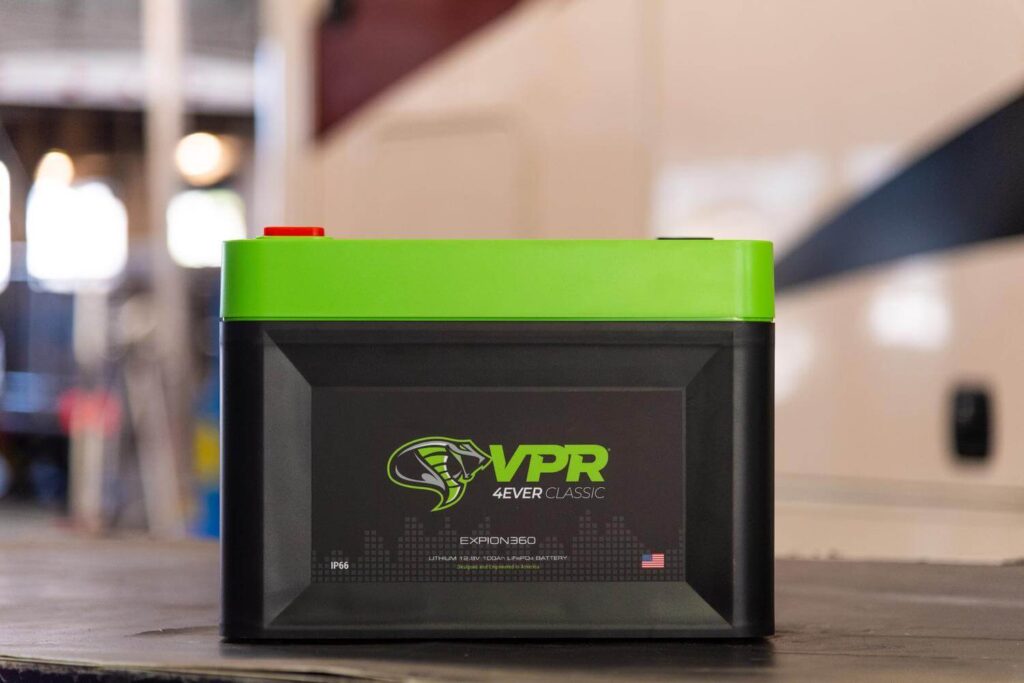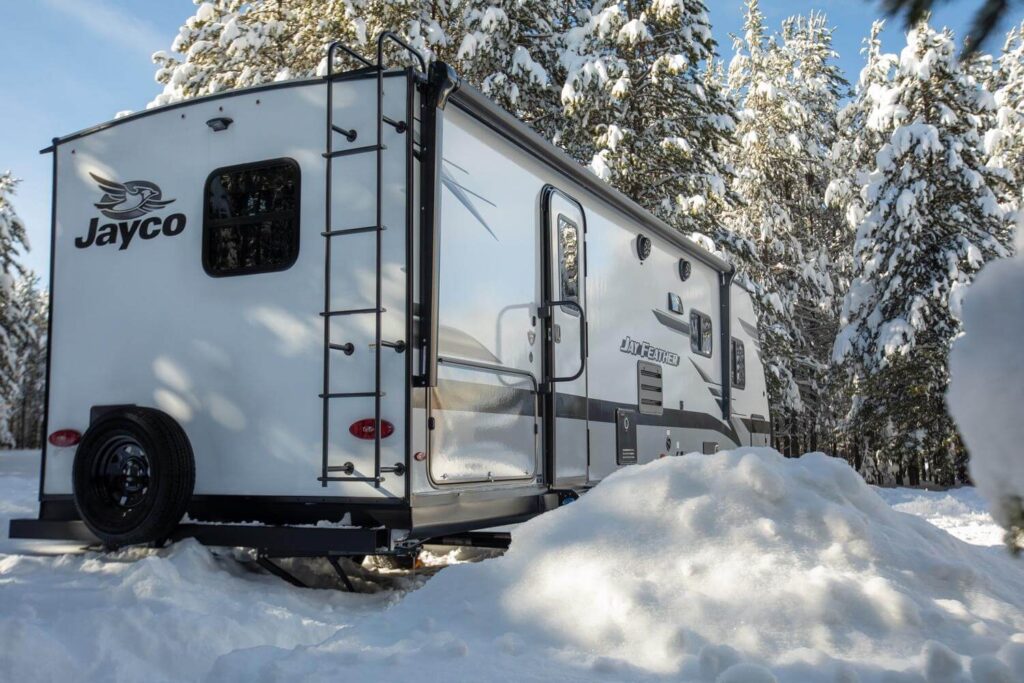KEEPING YOUR RV’S BATTERY SYSTEM in top shape is essential to reliable performance and long service life. Regular maintenance can prevent surprises, extend battery life, and improve your RV lifestyle, whether you have lead-acid, AGM, or lithium (LiFePO4) batteries for your camper. This guide covers RV battery maintenance across all three battery types, plus special considerations for winter RV storage and voltage system differences.
Key Takeaways
- RV battery care partly depends on type: Lead-acid batteries require the most upkeep (cleaning, topping off water, avoiding deep discharge), AGM batteries are sealed but still need proper charging and monitoring, while lithium (LiFePO₄) batteries offer low-maintenance performance but demand correct charging, safe storage, and temperature awareness.
- Winter storage matters: For long-term or cold-weather storage, clean and protect terminals, disconnect or remove batteries, store lead acid and AGM batteries at 100% state of charge (90% for lithium) in a cool, dry place, and recharge every 3 months to prevent damage.
- System differences to note: Whether using 6-volt or 12-volt batteries, each unit must be monitored and maintained individually, following manufacturer charging guidelines and ensuring even distribution for optimal performance.
Table of Contents
ToggleTips for Lead Acid Battery Maintenance

Traditionally, flooded lead-acid batteries demand the most attention—think of off-gassing, water refills, and corrosion. However, most lead-acid batteries used in modern RVs are now sealed—also known as “maintenance-free.” However, this can be misleading because, in truth, all lead-acid batteries require proper maintenance to keep them efficient and safe.
Here are some lead-acid battery maintenance tips for traditional and sealed varieties:
- Keep terminals clean – Every 1-2 months (or when white/green buildup appears), apply a baking soda-water paste to terminals, scrub gently to remove corrosion, then rinse and dry.
- Practice corrosion prevention. After cleaning, coating terminals with dielectric grease will slow corrosion and protect metal surfaces.
- Avoid deep discharge – Don’t let charge drop below 50%. Deeper discharges shorten lifespan significantly.
- Use monthly equalization charge – For flooded types, run an equalization cycle regularly to balance cells and reduce sulfation. This is only necessary for non-sealed batteries, must be done precisely according to the manufacturer’s recommendation, and is best completed by a Camping World certified RV Technician—some batteries can be damaged if equalized, or if equalization isn’t done properly.
- Watch for sulfation—fully recharge promptly – Always recharge soon after discharge to avoid hard sulfation, which impairs capacity. Using any water other than distilled will also mineralize the plates.
- Top off non-sealed batteries with distilled water regularly. After charging, check electrolyte levels; refill with distilled water so plates are submerged, typically ¼ to ½ inches above them.
If lead-acid batteries sound too demanding, lithium alternatives offer a low-maintenance, high-efficiency experience—though they still have a unique lithium RV battery maintenance checklist.
Technician Tip: AGM batteries are also temperature and vibration-tolerant, the terminals rarely corrode, and you never have to add distilled water.
How To Maintain Lithium RV Batteries

LiFePO4 (lithium iron phosphate) batteries offer lighter weight, longer life, zero off-gassing, and the ability to fully discharge without damage. Lithium battery maintenance still requires correct charging, voltage monitoring, and safe storage. So let’s walk through some of those maintenance requirements for LiFePO4 RV batteries.
Like lead-acid RV batteries, you should regularly clean lithium battery terminals and check that all connections are tight. There’s no need for baking soda, however, because there is no sulfuric acid that will cause corrosion. Still, light oxidation can occur at the terminals. You can simply use a dry cloth to clean the terminals and ensure connections are snug.
A smart preventative maintenance routine begins with using a multimeter to monitor the battery’s voltage and state of charge (SOC) monthly. A fully charged LiFePO4 RV battery should read approximately 14.1 to 14.6 volts.
Speaking of charging, lithium batteries can create significant safety risks if overcharged, especially if using an inappropriate float voltage. It’s imperative to use a compatible charger and avoid float charging.
LiFePO4 RV batteries can also be quite temperature sensitive, and charging them at extremes can damage the chemistry or the battery management system (BMS). You must charge lithium batteries within a safe temperature range, typically recommended by the battery’s manufacturer. However, it’s generally considered safe to charge lithium batteries between 34°F and 140°F (1 °C–60 °C).
While these batteries are more tolerant of deeper discharges than lead-acid varieties, it’s still smart to avoid deep discharge. Luckily, the built-in battery management system (BMS) should control the charge and discharge range. The best lithium battery for RV use will also have high and low temperature cutoffs, as well as overcurrent protection.
For long-term storage, LiFePO4 RV batteries have the advantage of being ready for service for years on the shelf, but should be checked quarterly. Run a charge/discharge cycle every three months and ensure your batteries are stored at 90% capacity.
Read more about how to charge RV battery types.
Caring for AGM RV Batteries
AGM (Absorbed Glass Mat) batteries are sealed, lead-acid variants that don’t require watering or equalizing. Compared to flooded lead-acid, they are maintenance-free, sealed, and safer. They are also the most temperature and vibration-tolerant battery type.
However, unlike lithium, they still suffer from sulfation and require proper charging profiles. You should monitor voltage and SOC regularly, avoid letting the charge drop too low, and store them in a cool, dry location. They don’t need electrolyte refills, but still benefit from clean, tight terminals.
RV Battery Winter Maintenance Recommendations

When your RV sits for more than 30 days—or is left in storage during the colder months—batteries need extra care to avoid damage from temperature and self-discharge. Use these tips to practice proper RV battery winter maintenance:
- Clean terminals before storage. Remove corrosion and apply protective grease so connections stay clean through the winter.
- Disconnect or remove batteries when possible. Use a disconnect switch or remove batteries to reduce parasitic draw and freeze risk.
- Store in a cool, dry location. Here’s a quick breakdown of recommended storage temperatures for lead-acid and lithium batteries:
- Lead-acid: 50–80°F (10–27°C)
- LiFePO₄: 50–95°F (10–35°C)
- Maintain SOC at 90-100%. Avoiding excessive battery discharge prevents degradation during long-term storage. Check and recharge every 3 months, at minimum.
- Avoid charging in freezing temperatures. Cold charging can cause damage to any type of RV battery.
12-volt vs 6-volt RV Batteries
Finally, let’s clarify how RV battery maintenance differs for 6-volt vs 12-volt battery banks. But first, understand the voltage differences for these batteries. For a 12V lead-acid battery, float voltage is around 13.4 volts; for a 6V battery (series pair), expect ~6.7 volts per battery or ~13.4 volts combined. 6V batteries are often used in series pairs to form a 12V system, offering higher capacity and depth-of-discharge resilience.
Regardless of configuration, each cell or battery must be maintained separately. This requires monitoring each battery’s voltage and water level (for flooded types). Whether 6V or 12V, follow the manufacturer’s charge rate guidelines and ensure even charge distribution through good wiring practices.
Regardless of voltage, best practices apply to each battery: 90-100% SOC, cool and dry location, terminal protection, and periodic charging.
Use these additional resources to care for or upgrade your RV’s energy storage capability.
What questions do you have about these RV battery maintenance guidelines? Let us know in the comments below!
Author
-

Tucker Ballister is our Content Strategist. He grew up RV camping in a Fleetwood Bounder with his parents and has lived and camped in two motorhomes and two travel trailers of his own. His current RV is a 2025 Forest River Campsite Ultra 26BW, which he loves taking on adventures with his wonderful partner and furry companion from their home base in Western North Carolina. Check out his adventures, gear reviews, and outdoor advice at thebackpackguide.com.
View all posts








